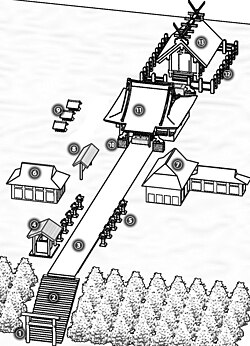
Back Liste der Nationalschätze Japans (Schreine) German Liste des Trésors nationaux du Japon (sanctuaires) French
The number of Shinto shrines in Japan today has been estimated at more than 150,000.[1] Single structure shrines are the most common. Shrine buildings might also include oratories (in front of main sanctuary), purification halls, offering halls called heiden (between honden and haiden), dance halls, stone or metal lanterns, fences or walls, torii and other structures.[2] The term "National Treasure" has been used in Japan to denote cultural properties since 1897.[3] The definition and the criteria have changed since the inception of the term. The shrine structures in this list were designated national treasures when the Law for the Protection of Cultural Properties was implemented on June 9, 1951. As such they are eligible for government grants for repairs, maintenance and the installation of fire-prevention facilities and other disaster prevention systems. Owners are required to announce any changes to the National Treasures such as damage or loss and need to obtain a permit for transfer of ownership or intended repairs.[4] The items are selected by the Ministry of Education, Culture, Sports, Science and Technology based on their "especially high historical or artistic value".[5][6] This list presents 42[nb 1][nb 2] entries of national treasure shrine structures from 12th-century Classical Heian period to the early modern 19th-century Edo period. The number of structures listed is actually more than 42, because in some cases groups of related structures are combined to form a single entry. The structures include main halls (honden), oratories (haiden), gates, offering halls (heiden), purification halls (haraedono) and other structures associated with shrines.[6]

- ^ Kishida 2008, p. 34
- ^ Ono & Woodard 2004, pp. 26–27
- ^ Coaldrake, William Howard (2002) [1996]. Architecture and authority in Japan. London, New York: Routledge. p. 248. ISBN 0-415-05754-X. Archived from the original on 2023-02-19. Retrieved 2009-11-01.
- ^ "Preservation and Utilization of Cultural Properties" (PDF). Administration of Cultural Affairs in Japan ― Fiscal 2009. Agency for Cultural Affairs. 2010. Archived from the original (PDF) on 2011-05-23. Retrieved 2011-05-08.
- ^ "Cultural Properties for Future Generations" (PDF). Tokyo, Japan: Agency for Cultural Affairs, Cultural Properties Department. March 2017. Archived from the original (PDF) on 2017-12-16. Retrieved 2017-12-17.
- ^ a b 国指定文化財 データベース [Database of National Cultural Properties] (in Japanese). Agency for Cultural Affairs. 2008-11-01. Archived from the original on 2009-03-30. Retrieved 2009-04-16.
Cite error: There are <ref group=nb> tags on this page, but the references will not show without a {{reflist|group=nb}} template (see the help page).